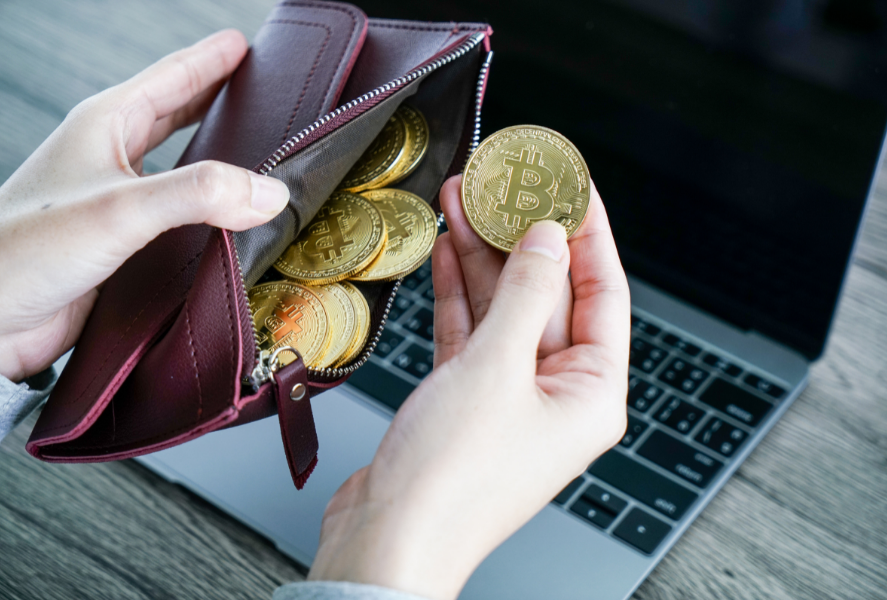08 Sep Types of Crypto Wallets: A Beginners Guide

If you’ve recently started buying cryptocurrency or if youve been acquiring crypto for a while now, you’ve heard of crypto wallets.
If you think youre safe keeping your Bitcoin, Etherium, or other coins on a crypto exchange, we have one piece of advice for you…
Get your cryptocurrency off the exchanges. Now.
A foundational principle of the crypto community is self-reliance and responsibility for oneself… And one’s cryptocurrency assets.
There is no institution that’s going to save you if you misplace your private keys.
This may bother some of you. If you dont trust yourself to not lose your investments, then crypto may not be right for you.
But if you hold crypto assets and youre keeping your investments on an exchange, its time to consider a wallet.
Why Get Your Cryptocurrencies off the Exchange
Even if the exchange offers security features such as…
- Secure password that’s a mix of regular and capital letters, symbols, and numbers
- Two-factor authentication (2FA)
- Cold storage options
- Ability to whitelist IP and withdrawal addresses
- Fund insurance (like Coinbase and Coinbase Pro, Circle, and Gemini do)
…your crypto is still at risk of being taken by hackers.
Lets take a look at the data, shall we?
According to Inside Bitcoins, more than us $11 billion has been stolen from secure crypto exchanges, wallets, and mining platforms since 2011. Most of which was lost due to exchange hackings.
“In the history of blockchain, 2019 recorded the highest number of hacks with at least eight establishments suffering hacks,” Inside Bitcoin reports.
“Interestingly, the largest cryptocurrency exchange binanace lost 7,000 btc ($60.5 million), an event that rocked the industry. Hackers used a variety of techniques including phishing and viruses to obtain a large amount of user data.”
If you’re keeping your Bitcoin, Etherium, or alt coins on an exchange, its time to invest in a crypto wallet to protect your assets!”
What Are Crypto Wallets?
In theory, its no different from the wallet in your purse.
Except you are really just storing a private secure key and public address that allow you to interact with the blockchain and store and retrieve your assets.
Types of Crypto Wallets
Wallets can be broken down into 3 main types…
- Hardware wallet
- Software wallet
- Paper wallet
Sometimes you’ll hear crypto wallets defined as “hot” or “cold” wallets.
In the simplest terms, a hot wallet is connected to the internet (i.e., a software wallet). A cold wallet has no connection to the internet (i.e., hardware and paper wallets).
Hardware Crypto Wallets
Hardware wallets, often referred to as cold wallets, are physical devices that you can hold in your hand.
Except they don’t actually hold anything. Instead, the hardware wallet stores your private key.
Through this private key, you can access your crypto, which is stored on the blockchain (which is where your digital assets live).
From this type of crypto wallet, you can store, send, and receive crypto.
Hardware wallets are a USB-drive-looking thing with a screen and buttons. They are typically batteryless, and you can plug them into your computer or phone to charge.
The best part about hardware wallets is that they mitigate risks of your crypto being attacked online because the key is stored on the device and the device is not connected to the internet.
When you set them up, they ask you for a PIN to protect your device and a recovery phrase to use should you lose your wallet.
(Another reason we love hardware wallets – you can retrieve your cryptocurrency if you have your PIN code and recovery phrase.)
They are a good idea to have if you hold large amounts of crypto or you plan on holding coins for a long time. Or if you just want to protect your crypto investments.
While hardware wallets are one of the most secure, that doesn’t mean they can’t be attacked by hackers.
If you don’t set up the wallet properly or if you fall prey to a phishing scam, you can have your wallet emptied.
Another downside to hardware wallets is that they’re a bit difficult to figure out and aren’t as user-friendly.
However, if we can set one up, so can you! It’s not as hard as it first appears.
Hardware wallets can be pricey – between $75 and $150 – but are well worth the investment.
Trezor and Ledger are 2 highly reputable hardware wallets worth looking into.
We personally use the Ledger Wallet, and love it.
If you’re intimidated at first because you’re not the most tech-savvy person, don’t worry.
Once your device arrives, Ledger walks you through how to set it up.
Software Crypto Wallets
Software wallets are often referred to as hot wallets, as they are somehow connected to the internet.
Types include mobile, web, and desktop wallets.
Let’s break it down, shall we?
Mobile Wallets
Mobile wallets are one of the most used wallets.
They are uber convenient and allow you to easily send and receive crypto via QR codes…anywhere, anytime you have your smartphone on you.
They’re helpful if you make regular payments and transactions.
However, just like desktop and web wallets, they are always connected to the internet and are subspectile to malware and malicious apps.
You can encrypt your mobile wallet which will protect your crypto if your phone breaks or is lost.
Before downloading a mobile crypto wallet, you need to do your research.
Trusted wallets should have the following features…
- You control your private keys.
- Active development community.
- Backup and restore options.
- Compatible with a variety of operating systems.
Desktop Wallet
A desktop wallet is a software you download on your computer where you have complete control over your keys and cryptocurrencies.
It’s advisable to download a crypto desktop wallet on a computer that you don’t use daily, and one that’s not constantly connected to the internet.
It works like this: When you install the crypto wallet, it downloads and is stored on your computer.
The file contains your private key, and you need to encrypt it for security.
When you do this, you’ll be required to provide the password every time you run the software.
If you don’t regularly backup your wallet file and/or keep it somewhere safe, should you lose this file or forget your password, you may not get access to your crypto again.
Web Wallet
Web wallets are popular because you can easily access the blockchain without having to install or download anything. All you need is an internet browser, password, and voila! You can access your wallet.
But they are the least secure.
In a web wallet, your private keys are keys online inside the wallet or, in some cases, in your browser.
They are either hosted or non-hosted.
A hosted wallet is the least secure because you don’t have complete control over your assets. Should the hosted wallet get hacked or DDoSed, you’re in trouble.
Exchange wallets are considered web wallets. Coinbase and CEX.io are examples of these.
Many people store their crypto in hosted exchange wallets because it’s easier for them to access and they don’t have to deal with transferring to a different wallet type.
But this is dangerous because you don’t hold your private keys. If you don’t own your key, you don’t own your crypto.
A non-hosted wallet, like MetaMask, allows you control over your funds, but they are prone to DDoS attacks.
[If you’re wondering what a DDos attack is, Cloudflare breaks it down this way. “A distributed denial-of-service (DDoS) attack […] is like a traffic jam clogging up a highway, preventing regular traffic from arriving at its desired destination.”]
Paper Wallets
Paper wallets are exactly as they sound…a piece of paper that contains a private key printed out in the form of QR codes.
You simply scan the code with a smartphone to execute transitions or manually type in the key.
While paper wallets are great for protecting your crypto from hackers, the downside is that it’s actual paper, and, realistically, can you keep track of it or not spill on it?
Another downside is that they aren’t suitable for sending partial funds. In fact, it’s a pain. in the butt.
If you wanted to send 1 Bitcoin to a friend and you had 7 BTC in your paper wallet, you’d have to send all 7 BTC to another type of wallet and then do what you want with the 1 BTC. Then, you’d have to send the remaining 6 BTC back to the paper wallet.
If you don’t transfer all the BTC at once, the remaining 6 BTC will be automatically transferred to something called a change address.
If you don’t set up the change address to one you control, you will lose your funds.
Long and short of it, don’t use a paper wallet.
Our Crypto Wallet Recommendation
If you currently have crypto on an exchange, get it off there as soon as possible.
There’s nothing wrong with storing a small amount to trade on an exchange, but it’s just not safe.
It’s your crypto, and it’s your responsibility to make sure it’s secure.
We recommend you do your research and find the crypto wallet that makes the most sense for you.
We own both the Ledger Nano X and the Nano S, and highly recommend both of them.
The Ledger Nano X stores up to 100 apps and is compatible with 1,250+ coins, including Bitcoin, Etherium, Tezos, EOS, XRP, and more.
It’s wireless and has Bluetooth capability – meaning, you can either use your desktop or your phone to make a transaction or check balances.
The Ledger wallet also allows you to stake certain cryptocurrencies and earn passive income.
It isn’t cheap, but if you plan to build your crypto portfolio, it’s well worth the investment.
We use our Ledger Nano S as a backup wallet.
It is smaller than the Nano X and holds from between 3 to 6 apps, depending on the app size.
The Nano S is $59 and is ideal to use as a backup wallet or if you are just starting to buy cryptocurrency and don’t have a lot yet.



Pingback:Stop Being Sold | 12 Ways to Keep Cryptocurrency Safe from Hackers
Posted at 23:03h, 15 September[…] Two-factor authentication (2FA) adds an extra layer of security to your crypto activities. […]
Pingback:7 Crypto Staking Risks [Investors Beware] - Stop Being Sold
Posted at 18:49h, 18 April[…] sure you remember your private keys. If you don’t, you won’t be able to access your crypto […]